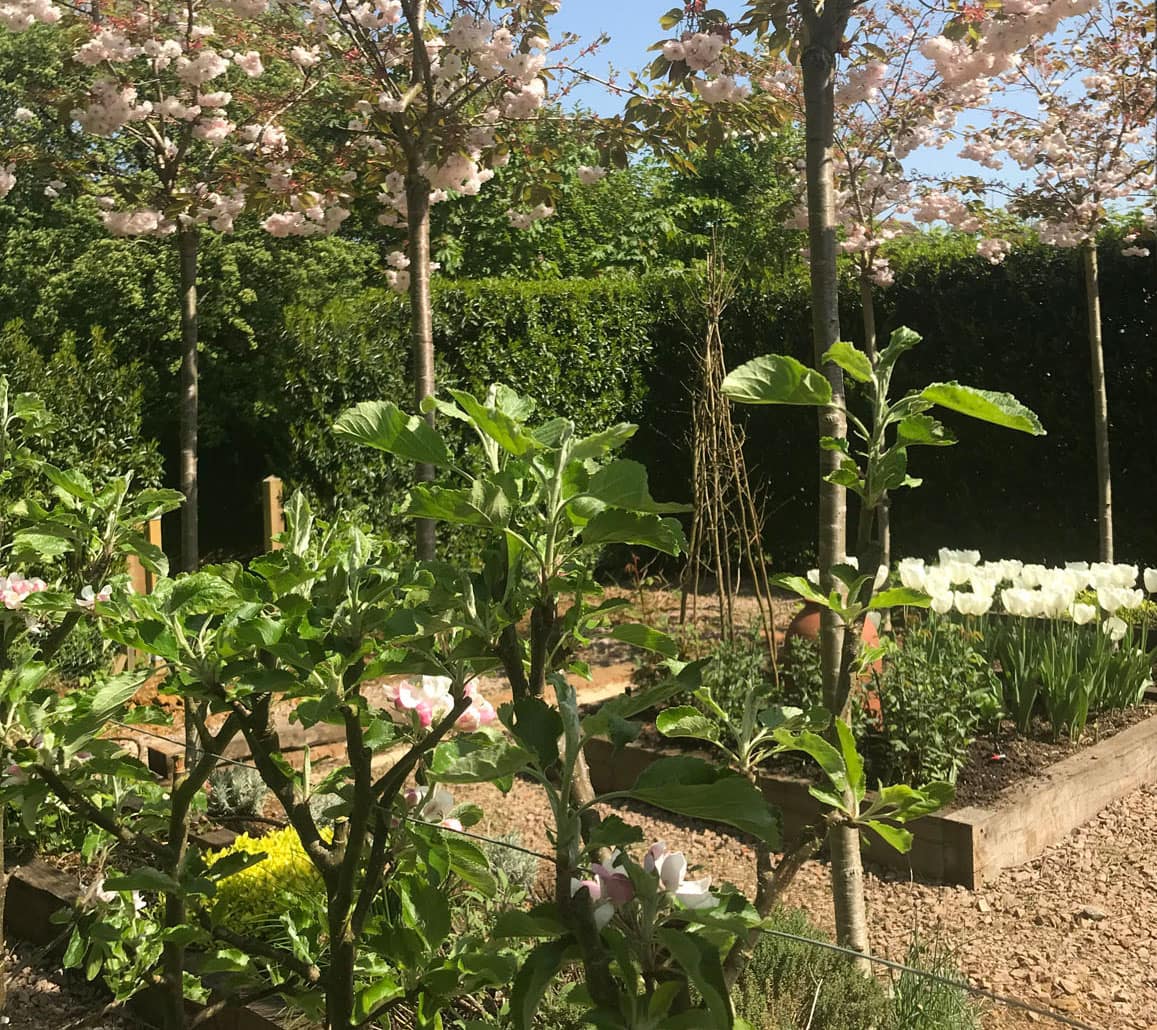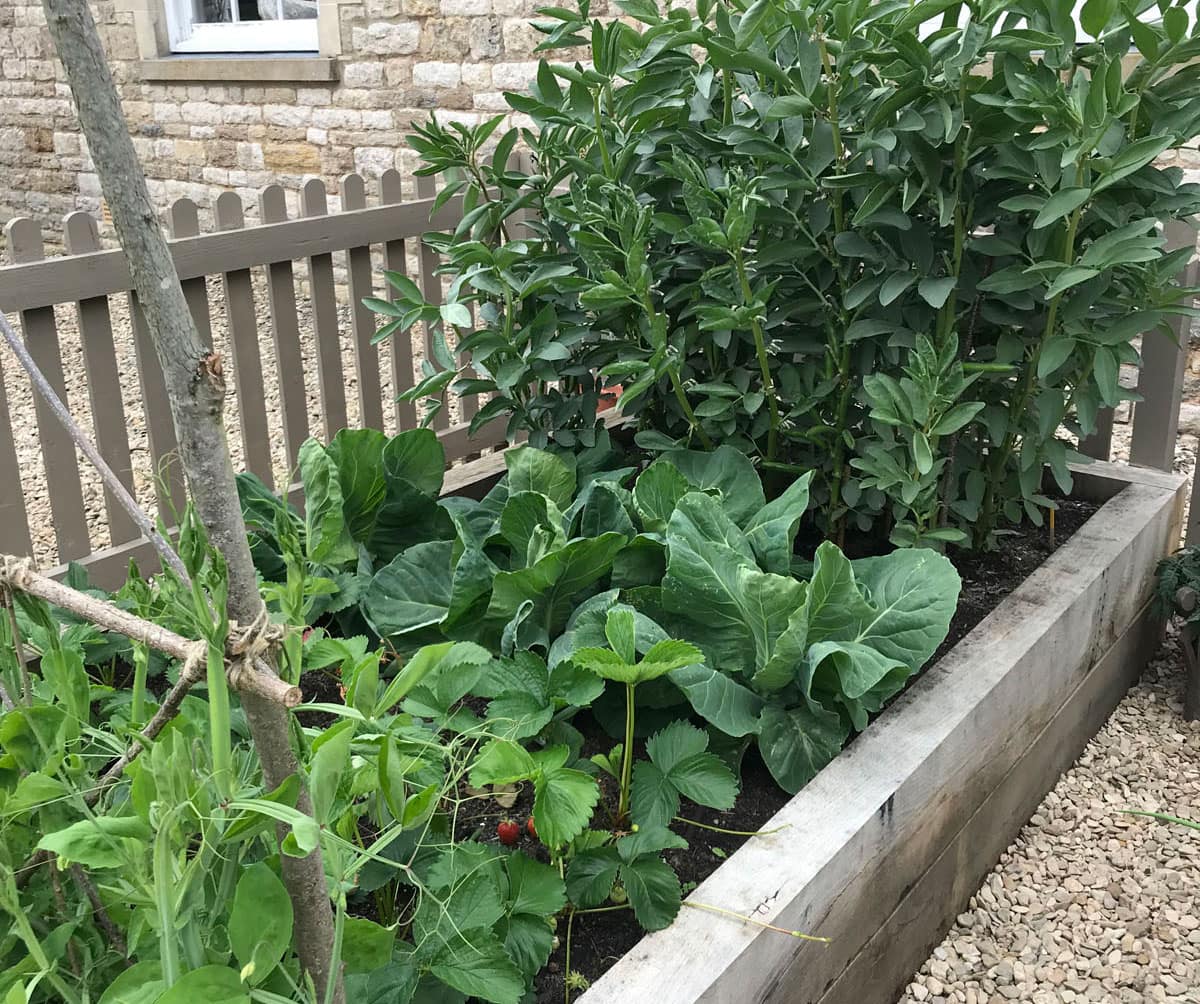If you’re new to vegetable gardening, then starting a kitchen garden can be a little daunting. So, we asked The Oxfordshire Gardener’s Head Gardener (and kitchen garden specialist) if he’d share his knowledge and aid all the budding ‘patch-to-plate’ growers out there in their goal of bounty of harvested booty.

My old Head Vegetable Gardener at Le Manoir aux Quat’Saisons used to explain to me that there is no better treat for the soil, and for ourselves, than to start a kitchen garden.
The symbiotic relationship between plant and soil is now more understood and valued than ever. Soil has a lifespan, it needs revitalising and needs replenishment. As plants grow and seek out nutrition by delving deeper, untouched topsoil is brought to the surface by worms, air pockets form for rainfall to flow through to the roots, both soil and plant work antagonistically to improve soils and expand their lifespan. Nothing does this better than a vegetable garden.

Food security has become a prevalent issue in the past two years, shortages of pasta, certain tropical fruits, and now in early 2023, Spanish droughts have been affecting stock levels across UK supermarkets. It has lifted the veil from the eyes of the population as to where our food comes from, and how reliant we are on the seemingly unfaltering chain of international trade.
So what do we turn to? We can keep buying the low quality, mass produced and expensively imported produce from our local supermarket or we can invest into producing for ourselves, connecting to where our food comes from, understanding seasonality, discovering deeper colours and textures in our food, and ultimately reaping the rewards in healthy, nutritious, abundant harvests of our own making.

Companion planting:
This was the single most important method of pest prevention we use. Planting carrots and leeks together in rows is a positive step when wanting to grow root veg. The odour of the leeks repels the presence of carrot root fly and the carrots do the same for leek moths.
Plant nasturtiums around your prized crops attract aphids that may want to chew through your tender cabbage and kale, and if the nasturtiums survive the ambush, then they too, both flower and leaf, can be enjoyed on a plate.
Calendula and marigolds are also great, as they offer interest ornamentally, whilst allowing your crops to relax from pests.

Many conversations have been had recently across the country on the topic of ‘do we really want to dig up our dahlia border to put in vegetables’. When the answer is yes, and agreed on by all concerned parties, it can seem like a daunting task, with soft landscaping, materials, seeds, trays, composts, stakes, irrigation, and even a greenhouse thrown in.
I have experienced it first hand. Those who’ve caught the kitchen garden bug can be keen to buy everything they can all at once. They’re naturally excited to have their first harvest, only to discover that radishes bolted, cabbages were ravaged by whitefly and their leeks had root rot. Let’s dispel some of these initial faults, and explain how we can maximise our yields, and our happiness.

The ‘Three Sisters’ method of growing is increasing in popularity, due to its simplicity, its inability to be affected by space, and its links to good permaculture. Growing corn, beans and squash together can be done in a small area and with great results. The corn provides a way for the beans to climb away from the busy canopy of squash foliage, whilst the beans fixate nitrogen through their roots to supplement the growth of all three plants. The shady cover of the squash plants prevents any competition from weeds, and retains moisture in the soil. No chemicals are used, no extensive planning required, just three plants growing in harmony, as they have done dating back to when Native Americans discovered the method.

Healthy hydration:
Even with proper implementation of these techniques, we are still at the mercy of Mother Nature and weather. Irrigation drip systems are the most efficient and cheapest method of watering, offering minimal wastage, targeted watering and cost-effectiveness. When water is allowed to slowly soak into the topsoil, it travels deep past the roots, drawing them to follow along, improving stability and anchorage of the plant.
In the heat of the summer, it may seem obvious to want to soak your garden, but the reality is that the majority will evaporate and the rest won’t travel to the roots. In hot temperatures, it’s best to avoid watering between 10am and 4pm as plants close their stomata, and stop taking up water to protect themselves from wilting.
Overwatering, also, can be an easy to overlook problem for a new kitchen gardener. Roots need water but they also need air, as it may seem natural to want to put all your new chilli seedlings into a trough of water to soak, but in reality if left too long, the roots begin to rot as they have no access to air and your first tray of seedlings decides to turn a nice shade of yellow.

Space to grow:
From experience, ‘thinning out’ feels like you’re committing a horticultural crime, but your beetroots, carrots, turnips, parsnips and radish will thank you for it. By removing 1 in every 3 plants from your newly sown line of seedlings, you’re allowing more room for your produce to grow. Yes, you could have 500 new radishes growing, but if they don’t have enough room to fully form then all you’ll be left with are tiny, red inedible pencils.
The urge to weed your patch everyday is a good one, as reducing competition for your harvest is an important thing to do, but it’s crucial to understand how and why we get weeds in our kitchen gardens. Seeds from neighbouring gardens and fields blow over and make themselves at home, nestled next to your onions and enjoying the second-hand watering they receive.
Tiny seedlings can be simply hoed off. Once the root connection is severed from the plant they can be left to burn off in the sun, however perennial weeds can be a bit more of an issue and require more effort to remove. Any tap root left in the soil will regrow year-after-year and become increasingly more resilient with each weeding attempt.

All the gear:
Fancy equipment won’t increase yields alone. The finest trowels and watering cans may be aesthetically pleasing, but won’t increase the success rate of your courgettes. Real understanding of seasonality, hardiness, plant requirements, harvesting and feeding times underpin a successful first attempt.
Ask yourself ‘What am I growing first?’, ‘Will I need to plant young plants in a small pot and place in a cold frame to acclimate and harden-off?’, ‘If I put this baby courgette out in mid-April, will a sharp frost kill it off?’, ‘Will these French Beans require a trellis or net to climb up?’, ‘When is the optimum time to harvest my pumpkins?’. Researching the answers to questions like these, should get the beginner kitchen gardener off to a good start.

The best vegetable gardeners I know have refined methods passed down from relatives, their former Head Gardeners and quirky, old gardening books. Their success is formed from years of trial and error. There will be failed crops, there will be awful weather at both ends of the spectrum, there will be a wild Muntjac that hops your fence at the sight of dinner and you will come back from holiday to find your vegetables swamped in chickweed and nettles, but it will be all worth it.
Whether you’re showing off your fancy new raised beds to a friend, sharing tips with colleagues, picking organic tomatoes for a weekend bruschetta or waiting patiently for your heritage pumpkin to fully ripen, growing food really is one of the most enriching, rewarding and natural things we can do to feed body and soul.
Ready to create your own kitchen garden? Let’s make plans.


